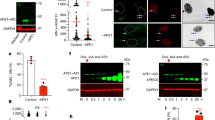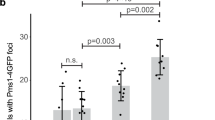Abstract
In the accompanying paper we demonstrated that endonuclease III-sensitive sites in theMATα andHMLα loci ofSaccharomyces cerevisiae are repaired by the Nucleotide Excision Repair (NER) pathway. In the current report we investigated the repair of endonuclease III sites, 6-4 photoproducts and cyclobutane pyrimidine dimers (CPDs) in arad14-2 point mutant and in arad14 deletion mutant. TheRAD14 gene is the yeast homologue of the human gene that complements the defect in cells from xeroderma pigmentosum (XP) patients belonging to complementation group A. In the point mutant we observed normal repair of endonuclease III sites (i.e. as wild type), but no removal of CPDs at theMATα andHMLα loci. Similar experiments were undertaken using the recently createdrad14 deletion mutant. Here, neither endonuclease III sites nor CPDs were repaired inMAT a orHMR a. Thus the point mutant appears to produce a gene product that permits the repair of endonuclease III sites, but prevents the repair of CPDs. Previously it was found that, in the genome overall, repair of 6-4 photoproducts was less impaired than repair of CPDs in the point mutant. The deletion mutant repairs neither CPDs nor 6-4 photoproducts in the genome overall. This finding is consistent with the RAD14 protein being involved in lesion recognition in yeast. A logical interpretation is that therad14-2 point mutant produces a modified protein that enables the cell to repair endonuclease III sites and 6-4 photoproducts much more efficiently than CPDs. This modified protein may aid studies designed to elucidate the role of the RAD14 protein in lesion recognition.
Similar content being viewed by others
References
Asahara H, Wistort PM, Bank JF, Bakerian RH, Cunningham RP (1989) Purification and characterisation ofE. coli endonuclease III from the clonednth gene. Biochemistry 28:4444–4449
Bankmann M, Prakash L, Prakash S (1992) YeastRAD14 and human xeroderma pigmentosum group A DNA-repair genes encode homologous proteins. Nature 355:555–558
Bohr VA, Smith CA, Okumoto DS, Hanawalt PC (1985) DNA repair in an active gene: removal of pyrimidine dimers from theDHFR gene of CHO cells is much more efficient than in the genome overall. Cell 40:359–369
Boiteux S (1993) Properties and biological functions of the Nth and Fpg proteins ofEscherichia coli: two DNA glycosylases that repair oxidative damage in DNA. Photochem Photobiol 19:87–96
Campbell I, Dufus JH (1988) Yeast: a practical approach. IRL Press, Oxford
Cleaver JE, Cortes F, Lutze LH, Morgan WF, Player AN, Vuksanovic L, Mitchell DL (1988) Unique DNA repair properties of a xeroderma pigmentosum revertant. Mol Cell Biol 7:3353–3357
Cleaver JE, McDowell MM, Jones C, Wood R, Karenz D (1994) Mutation and expression of theXPA gene in revertants and hybrids of a xeroderma pigmentosum cell line. Somatic Cell Mol Genet 20:327–337
Deschavanne PJ, Chavaudra N, Fertil B, Malaise EP (1984) Abnormal sensitivity of some Cockayne's syndrome cell strains to UV-and gamma-rays. Association with a reduced ability to repair potentially lethal damage. Mutation Research 131:61–70
Guzder SN, Sung P, Prakash L, Prakash S (1993) Yeast DNA-repair geneRAD14 encodes a zinc metalloprotein with affinity for ultraviolet-damaged DNA. Proc Nat Acad Sci USA 90: 5433–5437
Hoeijmakers JHJ (1993) Nucleotide excision repair II. From yeast to mammals. Trends Genet 9:211–217
Leadon SA, Lawrence DA (1992) Strand-selective repair of DNA damage in the yeastGAL7 gene requires RNA polymerase II. J Biol Chem 267:23175–23182
Leadon SA, Cooper PK (1993) Preferential repair of ionizing radiation-induced damage in the transcribed strand of an active human gene is defective in Cockayne syndrome. Proc Nat Acad Sci USA 90:10499–10503
Lehmann AR, Norris PG (1989) DNA repair and cancer: speculations based on studies with xeroderma pigmentosum, Cockayne's syndrome and trichothiodystrophy. Carcinogenesis 10:1353–1356
McCready S (1994) Repair of 6-4 photoproducts and cyclobutane pyrimidine dimers inrad mutants ofSaccharomyces cerevisiae. Mutation Res 315:261–273
McCready S, Cox B (1993) Repair of 6-4 photoproducts inSaccharomyces cerevisiae. Mutation Res 293:233–240
McDowell ML, Nguyen T, Cleaver JE (1993) A single-site mutation in theXPAC gene alters photoproduct recognition. Mutagenesis 8:155–161
Nakabeppu YK, Yamashita K, Sekiguchi M (1982) Purification and characterization of normal and mutant forms of T4 endonuclease V. J Biol Chem 257:2556–2562
Prakash S, Sung P, Prakash L (1993) DNA repair genes and proteins ofSaccharomyces cerevisiae. Annu Rev Genet 27:33–70
Reed SH, Boiteux S, Waters R (1996) UV-induced endonuclease III-sensitive sites at the mating type loci inSaccharomyces cerevisie are repaired by nucleotide excision repair: RAD7 and RAD16 are not required for their removal fromHMLα. Mol Gen Genet 250:505–514
Reynolds RJ, Friedberg EC (1981) Molecular mechanisms of pyrimidine dimer excision inSaccharomyces cerevisiae: incision of ultraviolet-irradiated deoxyribonucleic acid in vivo. J Bacteriol 146:692–704
Sherman F, Fink GR, Hicks JB (1986) Methods in yeast genetics, Cold Spring Harbor Laboratory Press, Cold Spring Harbor, New York
Svejstrup JQ, Wang Z, Feaver WJ, Wu X, Bushnell DA, Donahue TF, Friedberg EC, Kornberg RD (1995) Different forms of TFIIH for transcription and DNA repair: holo-TFIIH and a nucleotide excision repairosome. Cell 80:21–28
Sweder KS, Hanawalt PC (1992) Preferential repair of cyclobutane pyrimidine dimers in the transcribed strand of a gene in yeast chromosomes and plasmids is dependent on transcription. Proc Nat Acad Sci USA 89:10696–10700
Tanaka K, Miura N, Satokata I, Miyamoto I, Yoshida MC, Satoh, Y, Kondo S, Yasui A, Okayama H, Okada Y (1990) Analysis of a human DNA excision repair gene involved in group A xeroderma pigmentosum and containing a zinc-finger domain. Nature 348:73–76
Terleth C (1990) Differential DNA repair of UV damage in the yeastSaccharomyces cerevisiae. Ph.D. thesis, University of Leiden
Terleth C, Vansluis C, Van de Putte P (1989) Differential repair of UV damage inS. cerevisiae. Nucleic Acids Res 17:4433–4439
Venema J, Mullenders LHF, Natarajan AT, van Zeeland AA, Mayne LV (1990) The genetic defect in Cockayne Syndrome is associated with a defect in repair of UV-induced DNA damage in transcriptionally active DNA. Proc Nat Acad Sci USA 87:4707–4711
Wilcox DR, Prakash L (1981) Incision and postincision steps of pyrimidine dimer removal in excision-defective mutants ofSaccharomyces cerevisiae. J Bacteriol 148:618–623
Author information
Authors and Affiliations
Additional information
Communicated by B. J. Kilbey
Rights and permissions
About this article
Cite this article
Reed, S.H., Waters, R., McCready, S. et al. The levels of repair of endonuclease III-sensitive sites, 6-4 photoproducts and cyclobutane pyrimidine dimers differ in a point mutant forRAD14, theSaccharomyces cerevisiae homologue of the human gene defective inXPA patients. Molec. Gen. Genet. 250, 515–522 (1996). https://doi.org/10.1007/BF02174040
Received:
Accepted:
Issue Date:
DOI: https://doi.org/10.1007/BF02174040




